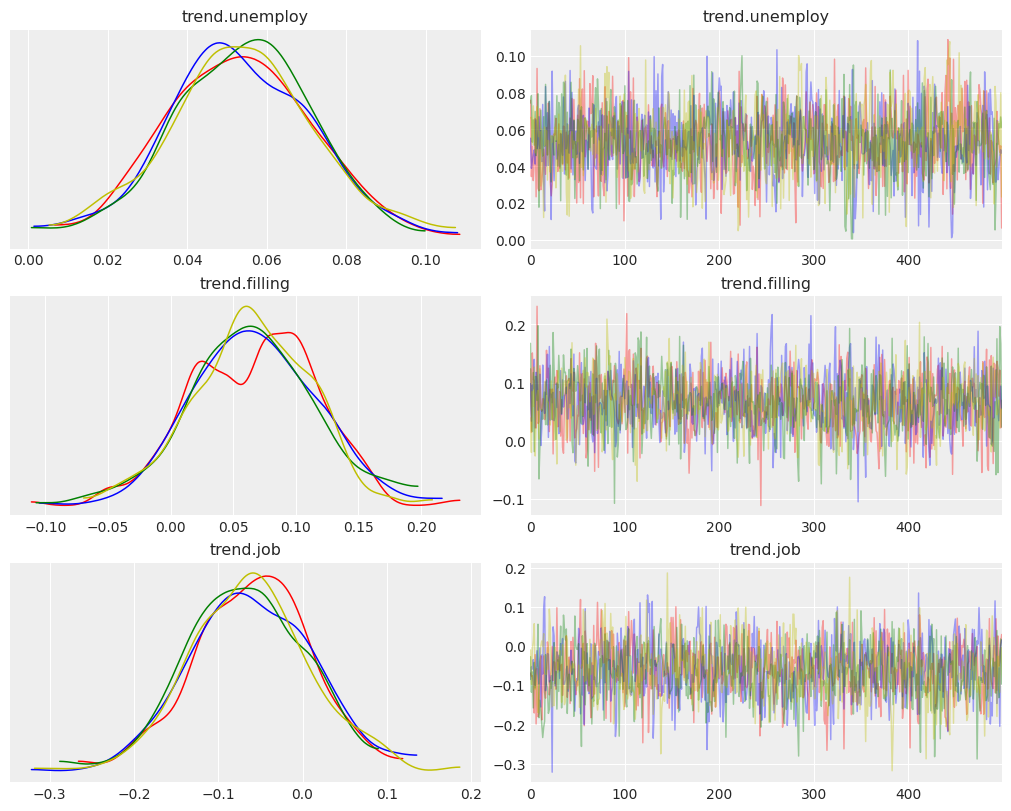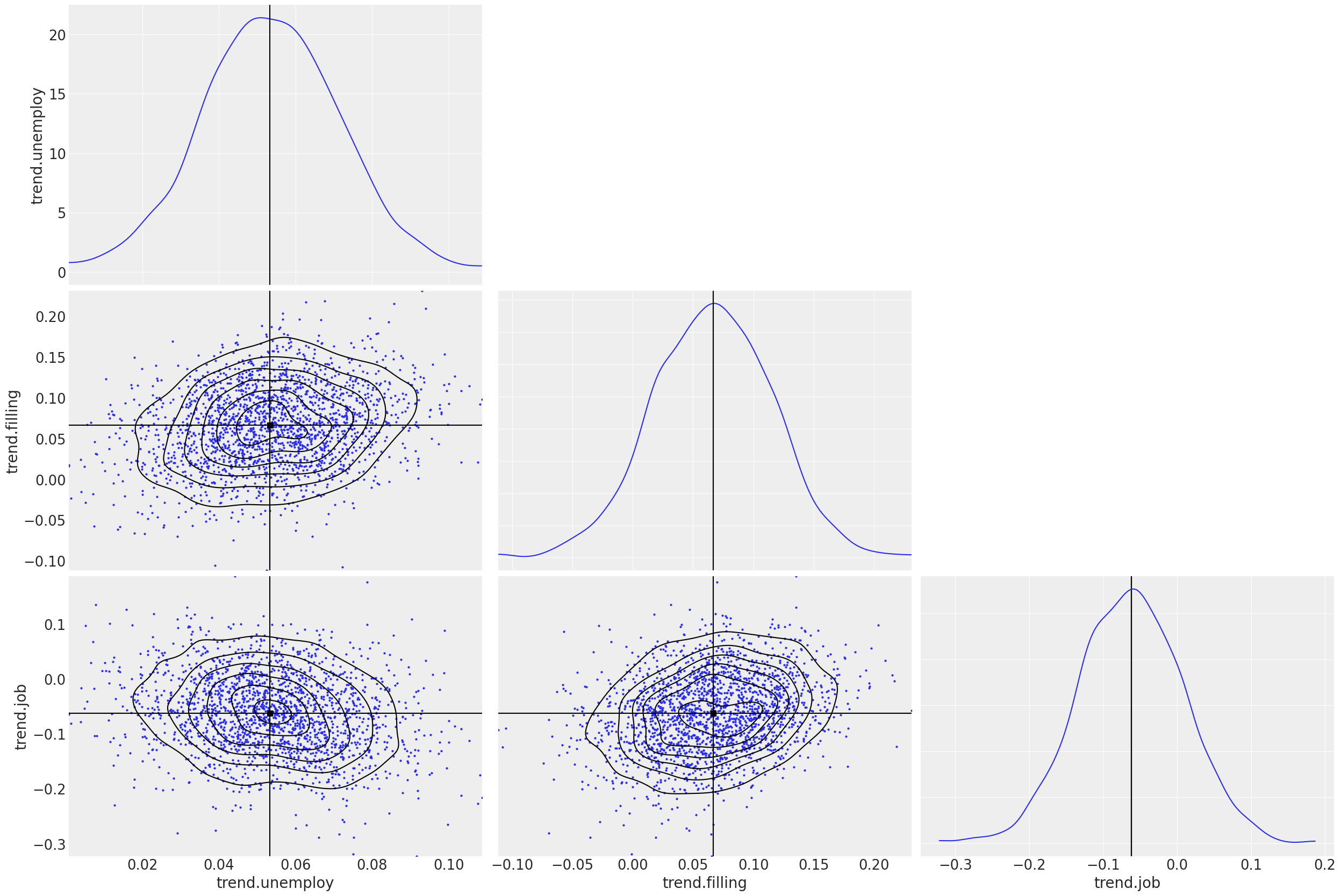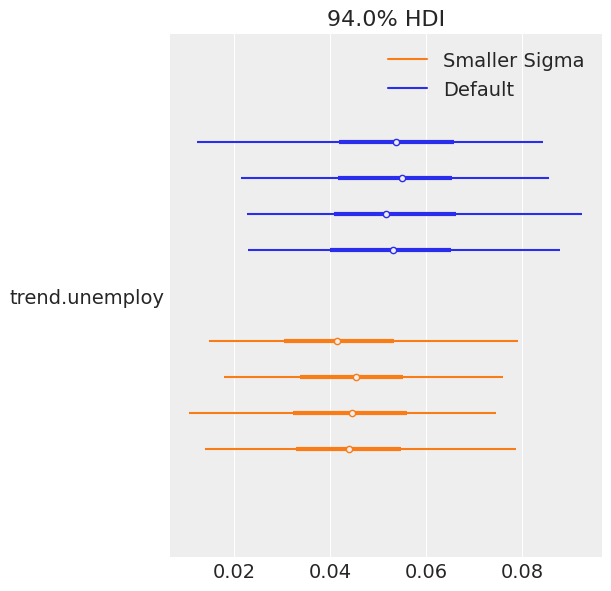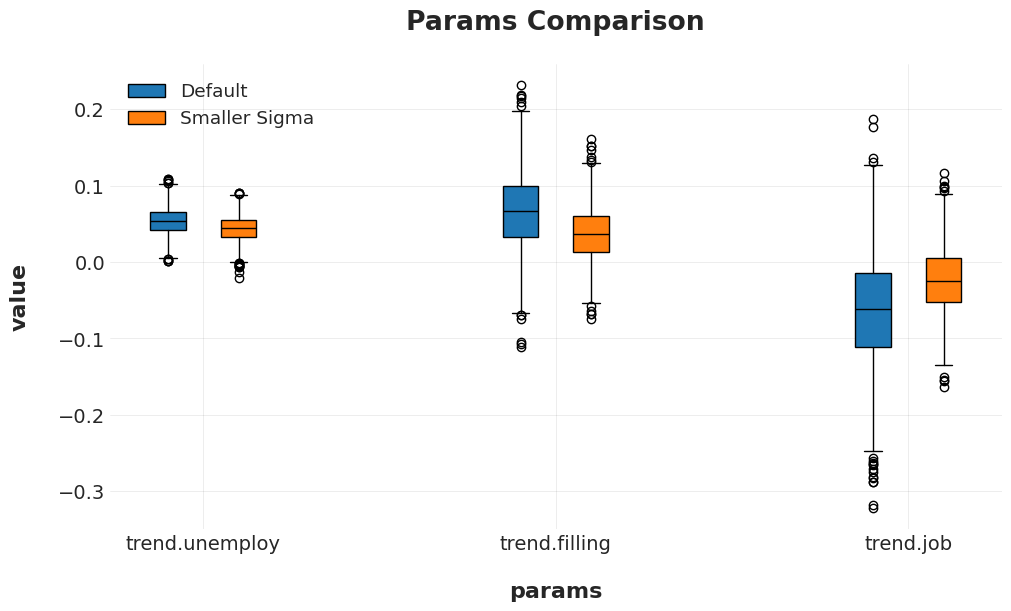Model Diagnostics¶
In this section, we introduce to a few recommended diagnostic plots to diagnostic Orbit models. The posterior samples in SVI and Full Bayesian i.e. FullBayesianForecaster and SVIForecaster.
The plots are created by arviz for the plots. ArviZ is a Python package for exploratory analysis of Bayesian models, includes functions for posterior analysis, data storage, model checking, comparison and diagnostics.
Trace plot
Pair plot
Density plot
[1]:
import pandas as pd
import numpy as np
import matplotlib.pyplot as plt
import arviz as az
import seaborn as sns
%matplotlib inline
import orbit
from orbit.models import LGT, DLT
from orbit.utils.dataset import load_iclaims
import warnings
warnings.filterwarnings('ignore')
from orbit.diagnostics.plot import params_comparison_boxplot
from orbit.constants import palette
[2]:
print(orbit.__version__)
1.1.4.6
Load data¶
[3]:
df = load_iclaims()
df.dtypes
[3]:
week datetime64[ns]
claims float64
trend.unemploy float64
trend.filling float64
trend.job float64
sp500 float64
vix float64
dtype: object
[4]:
df.head(5)
[4]:
| week | claims | trend.unemploy | trend.filling | trend.job | sp500 | vix | |
|---|---|---|---|---|---|---|---|
| 0 | 2010-01-03 | 13.386595 | 0.219882 | -0.318452 | 0.117500 | -0.417633 | 0.122654 |
| 1 | 2010-01-10 | 13.624218 | 0.219882 | -0.194838 | 0.168794 | -0.425480 | 0.110445 |
| 2 | 2010-01-17 | 13.398741 | 0.236143 | -0.292477 | 0.117500 | -0.465229 | 0.532339 |
| 3 | 2010-01-24 | 13.137549 | 0.203353 | -0.194838 | 0.106918 | -0.481751 | 0.428645 |
| 4 | 2010-01-31 | 13.196760 | 0.134360 | -0.242466 | 0.074483 | -0.488929 | 0.487404 |
Fit a Model¶
[5]:
DATE_COL = 'week'
RESPONSE_COL = 'claims'
REGRESSOR_COL = ['trend.unemploy', 'trend.filling', 'trend.job']
[6]:
dlt = DLT(
response_col=RESPONSE_COL,
date_col=DATE_COL,
regressor_col=REGRESSOR_COL,
seasonality=52,
num_warmup=2000,
num_sample=2000,
chains=4,
stan_mcmc_args={'show_progress': False},
)
[7]:
dlt.fit(df=df)
2024-03-19 23:39:45 - orbit - INFO - Sampling (CmdStanPy) with chains: 4, cores: 8, temperature: 1.000, warmups (per chain): 500 and samples(per chain): 500.
[7]:
<orbit.forecaster.full_bayes.FullBayesianForecaster at 0x294cf72d0>
We can use .get_posterior_samples() to extract posteriors. Note that we need permute=False to retrieve additional information such as chains when we extract posterior samples for posteriors plotting. For regression, in order to collapse and relabel regression from parameters (usually called as beta), we use relabel=True.
[8]:
ps = dlt.get_posterior_samples(relabel=True, permute=False)
ps.keys()
[8]:
dict_keys(['l', 'b', 'lev_sm', 'slp_sm', 'obs_sigma', 'nu', 'lt_sum', 's', 'sea_sm', 'gt_sum', 'gb', 'gl', 'loglk', 'trend.unemploy', 'trend.filling', 'trend.job'])
Diagnostics Visualization¶
In the following section, we are going to use the regression coefficients as an example. In practice, you could check other parameters extracted from the model. For now, it only supports 1-D parameter which in generally capture the most important parameters of the model (e.g. obs_sigma, lev_sm etc.)
Convergence Status¶
Trace plots help us verify the convergence of model. In general, a largely overlapped distribution across samples from different chains indicates the convergence.
[9]:
az.style.use('arviz-darkgrid')
az.plot_trace(
ps,
var_names=['trend.unemploy', 'trend.filling', 'trend.job'],
chain_prop={"color": ['r', 'b', 'g', 'y']},
figsize=(10, 8),
);

Note that this is only applicable for FullBayesianForecaster using sampling method such as MCMC.
Samples Density¶
We can also check the density of samples by pair plot.
[10]:
az.plot_pair(
ps,
var_names=['trend.unemploy', 'trend.filling', 'trend.job'],
kind=["scatter", "kde"],
marginals=True,
point_estimate="median",
textsize=18.5,
);

Compare Models¶
You can also compare posteriors across different models with the same parameters. You can use plots such as density plot and forest plot to do so.
[11]:
dlt_smaller_prior = DLT(
response_col=RESPONSE_COL,
date_col=DATE_COL,
regressor_col=REGRESSOR_COL,
regressor_sigma_prior=[0.05, 0.05, 0.05],
seasonality=52,
num_warmup=2000,
num_sample=2000,
chains=4,
stan_mcmc_args={'show_progress': False},
)
dlt_smaller_prior.fit(df=df)
ps_smaller_prior = dlt_smaller_prior.get_posterior_samples(relabel=True, permute=False)
2024-03-19 23:39:55 - orbit - INFO - Sampling (CmdStanPy) with chains: 4, cores: 8, temperature: 1.000, warmups (per chain): 500 and samples(per chain): 500.
[12]:
az.plot_density(
[ps, ps_smaller_prior],
var_names=['trend.unemploy', 'trend.filling', 'trend.job'],
data_labels=["Default", "Smaller Sigma"],
shade=0.1,
textsize=18.5,
);

[13]:
az.plot_forest(
[ps, ps_smaller_prior],
var_names=['trend.unemploy'],
model_names=["Default", "Smaller Sigma"],
);

[14]:
params_comparison_boxplot(
[ps, ps_smaller_prior],
var_names=['trend.unemploy', 'trend.filling', 'trend.job'],
model_names=["Default", "Smaller Sigma"],
box_width = .1, box_distance=0.1,
showfliers=True
);

Conclusion¶
Orbit models allow multiple visualization to diagnostics models and compare different models. We briefly introduce some basic syntax and usage of arviz. There is an example gallery built by the original team. Users can learn the details and more advance usage there. Meanwhile, the Orbit team aims to continue expand the scope to leverage more work done from the arviz project.